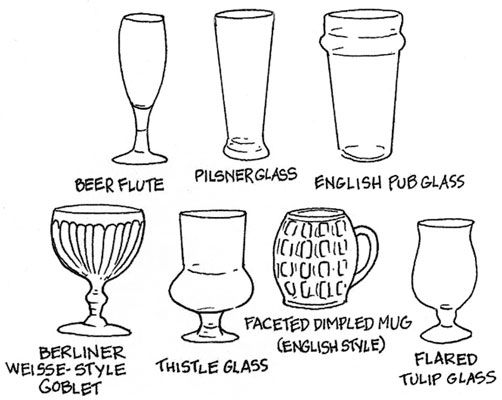Traditionally, certain beers have a specific glass style associated with them. Using these glasses is a sign of your high regard for great beer. The nice thing about beer glassware, though, is that it doesn’t involve hard-and-fast rules. Not using these styles is a sign of being a normal person without really cool glassware, so don’t freak out if you lack a certain glass.
Simple beers can be served in simple glasses; well-aged and expensive beers should get the regal treatment. The table describes which basic glass to use for which kind of beer.
| Glass Description | Beer |
|---|---|
| Deep, tulip-shaped glasses | Strong beers, such as Belgian Ales |
| Simple pint glasses | Mild Ales and Brown Ales, Porters, Stouts |
| Small, brandy snifter–type glasses or even cordials | Rich and spirituous Barleywines, Old Ales, and Imperial Stouts |
| Thin, stemmed flutes | Some aromatic Trappist and Abbey Ales and Belgian Fruit Beers |
| Tall, narrow glasses | Light, spritzy, and aromatic beers, such as Pilsners and Witbiers |
| Tall, thick glasses | Wheat Beers |
| Wide-bowled goblets | Aromatic beers, such as Berliner Weisse |
You may run across some of the following glass styles in your beery journeys.
Altbier glass: The Altbier glass is a short, slim, cylindrical glass similar to a Tom Collins glass.
Beer flute: Rather thin and dainty with a stem and a base, the beer flute is used for Pilsners and similar beers but is meant for beers that emulate wines.
Dimpled pint mug: The dimpled pint mug was used at one time as the standard drinking vessel in British pubs.
Goblet: The goblet is used almost exclusively for Berliner Weisse and some Trappist and Abbey Ales.
Halbe: Meaning “half” in German, for half-liter, a halbe is a simple glass mug preferred by many Germans for everyday Helles.
Kölsch beer glass: The Kölsch beer glass is a taller version of the Altbier glass.
Krug: Krug literally means mug or tankard (it may also refer to a jug or pitcher). The krug is rather large and usually made of sturdy glass.
Mass: The mass is a large and heavy dimpled glass mug with a liquid capacity of 1 liter. This glass is the standard serving size at Munich’s Oktoberfest.
Middy: Of Australian origin, the middy size depends on where you’re drinking: In Sydney, a middy holds 10 ounces, but in Perth, it holds only 7.
Pilsner: The Pilsner glass comes in a variety of styles. The more elegant ones are tall and footed and made of wafer-thin glass; they hold 10 or 12 ounces.
Pint glass: Probably the most pedestrian and interchangeable of beer glasses, the standard — or shaker — pint glass is made of thick glass, tapers slowly outward toward the top, and holds 16 ounces of beer. The imperial pint glass holds 20 ounces of beer (not too common in the United States). The nonic (pronounced no knick) pint glass has a bulge near the top of the glass that protects the lip from nicks should the glass be tipped over (these bulges also allow the glasses to be stacked one inside the other without becoming stuck).
Pony: The pony is an Australian liquid measure of 1/5 pint. The actual glass may hold 4 or 5 ounces of beer.
Schooner: The schooner is typically a tall glass similar to a tumbler, measuring 15 ounces.
Schnelle: The schnelle is a tall, slender, tapered earthenware tankard with a hinged lid.
Sham: The sham is generally of small proportions, ranging from 5 to 10 ounces, regardless of shape.
Stein: The stein, or stone in German, is made of clay or ceramic and often features a hinged lid (usually made of pewter).
Thistle: The silhouette of the thistle glass is exactly as the name implies. The thistle is a uniquely shaped glass, almost exclusively used for strong Scottish Ales. They help intensify the beer’s aroma.
Tulip: The tulip glass shape closely resembles its name and is effective in capturing the aromatic qualities of beer. It’s favored for Belgian Strong Ales.
Tumbler: The tumbler can be rather pedestrian, but beveled edges add some panache. The tumbler is used for a wide variety of beer styles.
Weizen beer glass: Tall, shapely, wide-rimmed, with a capacity usually exceeding 18 ounces, the Weizen beer glass is designed to hold a half-liter of Wheat Beer and its towering head.


